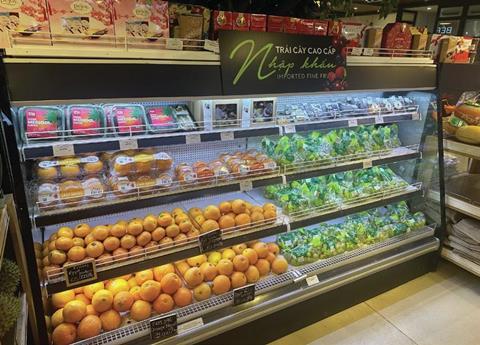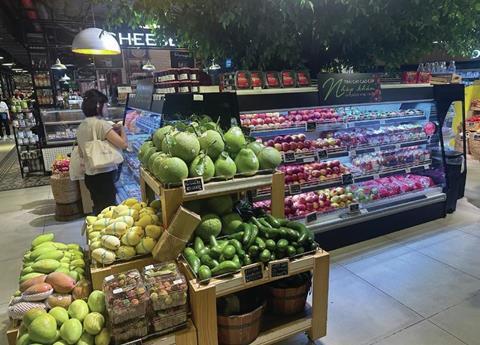Shifts in retail and consumer preferences open up new opportunities for fresh produce suppliers
Vietnam has been a market of interest for global fresh produce suppliers for some time. However, the market is changing. Recent shifts towards more value-orientated offerings, combined with rapid growth in modern retailing – including e-commerce and social media – and a push into second and third-tier cities, are providing opportunities for further expansion.

These were some of the key takeaways from an Asiafruit Congress session spotlighting Vietnam at Asia Fruit Logistica.
Hai Xuan Nguyen, chair of leading Vietnamese boutique fruit retailer Klever Fruit, said Vietnam’s economy has shown robust growth over the past few decades, with an average real growth rate of 6.1 per cent over ten years (2012 to 2022).
While this growth slowed to 5 per cent in 2023, forecasts suggest an increase to 6 per cent for 2024 – a sign of sustained momentum despite global economic uncertainty.
According to Nguyen, Vietnam’s population spends around 13 per cent of its income on fresh fruit and vegetables, equating to about 100kg of fresh produce per capita, annually.
In 2022, Vietnam’s total fruit imports were valued at US$1.96bn and for the first half of this year, the figure had already reached US$1.1bn.
With numbers like this, it’s easy to see why the market has been particularly interesting for globalfresh produce exporters. But it hasn’t been without risk.
“Many companies when doing business in Vietnam aim to achieve quick growth in the market, but they ignore several serious risks such as indebted risk, oversupply and price dumping that result in losses,” Nguyen said.
Vietnam has developed somewhat of a reputation for being a ‘claims market’, which has soured some supplier relationships. But Nyuyen said this is mostly affecting newer exporters who don’t yet have the proper understanding of the market.

“The second challenge is around the infrastructure,” he said. “The cold chain market in Vietnam can only meet 30 to 35 per cent of the demand.”
However, there are signs this is changing.
As the market matures, interest in second and third-tier cities is increasing. Regional cities beyond Ho Chi Minh and Hanoi such as Da Nang, Hai Phong and Can Tho are experiencing increased urbanisation and income levels, which has boosted demand for imported products.
“Every main player in the industry is trying to go into new provinces,” said Fruit-X Vietnam market manager Angel Mompo, during the ensuing Asiafruit Congress panel discussion. “The key to the continued growth in Vietnam, in terms of imports, is in developing those rural areas.”
In order to support this development, investment in infrastructure, roads and facilities like cold storage will follow.
“As the market is expanding, you have to go to the second-tier, thirdtier, and the infrastructure needs to be supporting that,” added Joy Wing Mau Asia’s general manager of trade, Danny Guo. “So, a lot of our partners are actually building their own cold storages in, for example, Da Nang.”
Shifting retail channels
According to research by Cimigo, consumers are increasingly shopping at modern retail stores including supermarkets. In 2015, modern retail made up 17 per cent of total sales revenue. This grew to 26 per cent in 2022, with over 9,000 retail stores nationwide operated by a mix of major local and internatioal players including Bach Hoa Xanh, WinMart, Saigon Co.op, Central Retail, Aeon and Lotte Mart.
Vietnam has also seen significant growth in e-commerce and online sales. Online retail accounted for 7.3 per cent of total retail revenue in 2022 , according to Cimigo, and is forecast to reach 31 per cent by 2025. This improved online infrastructure, and the rise of social media, has made way for another dominant trend: livestreaming.
“It’s one of the main tools if you want to reach more consumers,” said Mompo.
In many cases, livestreamers will connect with retailers to promote particular products and take a sales commission of 10 to 15 per cent. However, some have access to their own product lines and, according to Nguyen, classes have become available for farmers to take advantage of the trend and stream themselves.
“Livestreaming is amazing,” he said. “One household with no store at all can livestream on Facebook or on TikTok and in one day – with three to five livestream sessions – make about US$3,000 to US$5,000.”
Nguyen said Klever Fruit livestreams twice a day.
Consumer preferences

Consumer preferences are also shifting. Vietnam traditionally has a reputation as a market with very strict size, colour and quality requirements for imported fruits, but it is now taking a much broader range of products.
“The spending power has definitely been affected in Vietnam,” Guo said. “The market for imported fruits is still growing but the focus has shifted a little bit.”
Guo pointed to the rising popularity of smaller-sized apples from South Africa and China’s dominant position in the market.
“The price-quality ratio is outstanding [for China] and it’s actually a very good fit for the current economic situation,” he said.
Looking ahead
Despite a slight cooling off period following the earlier boom, Nguyen, Guo and Mompo see immense potential for the Vietnamese market – particularly with movement towards provincial cities and interest in an expanded product range.
“We are very, very positive for what’s going to be the outcome of the next five years in Vietnam,” Mompo said.
Fruitnet is launching Fresh Produce Vietnam, the brand-new conference and expo event for Vietnam’s booming fresh produce business, on 13-14 May 2025 in Ho Chi Minh City. Visit the website for more information:



